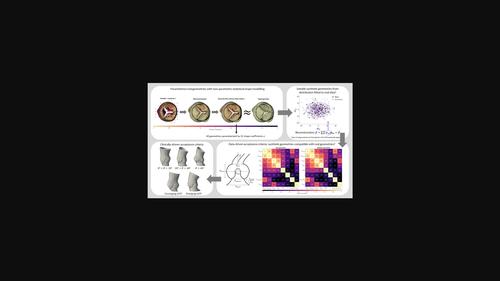当前位置:
X-MOL 学术
›
Int. J. Numer. Method. Biomed. Eng.
›
论文详情
Our official English website, www.x-mol.net, welcomes your feedback! (Note: you will need to create a separate account there.)
Generation of synthetic aortic valve stenosis geometries for in silico trials
International Journal for Numerical Methods in Biomedical Engineering ( IF 2.1 ) Pub Date : 2023-11-14 , DOI: 10.1002/cnm.3778 Sabine Verstraeten 1 , Martijn Hoeijmakers 2 , Pim Tonino 3 , Jan Brüning 4 , Claudio Capelli 5 , Frans van de Vosse 1 , Wouter Huberts 1, 6
International Journal for Numerical Methods in Biomedical Engineering ( IF 2.1 ) Pub Date : 2023-11-14 , DOI: 10.1002/cnm.3778 Sabine Verstraeten 1 , Martijn Hoeijmakers 2 , Pim Tonino 3 , Jan Brüning 4 , Claudio Capelli 5 , Frans van de Vosse 1 , Wouter Huberts 1, 6
Affiliation

|
In silico trials are a promising way to increase the efficiency of the development, and the time to market of cardiovascular implantable devices. The development of transcatheter aortic valve implantation (TAVI) devices, could benefit from in silico trials to overcome frequently occurring complications such as paravalvular leakage and conduction problems. To be able to perform in silico TAVI trials virtual cohorts of TAVI patients are required. In a virtual cohort, individual patients are represented by computer models that usually require patient-specific aortic valve geometries. This study aimed to develop a virtual cohort generator that generates anatomically plausible, synthetic aortic valve stenosis geometries for in silico TAVI trials and allows for the selection of specific anatomical features that influence the occurrence of complications. To build the generator, a combination of non-parametrical statistical shape modeling and sampling from a copula distribution was used. The developed virtual cohort generator successfully generated synthetic aortic valve stenosis geometries that are comparable with a real cohort, and therefore, are considered as being anatomically plausible. Furthermore, we were able to select specific anatomical features with a sensitivity of around 90%. The virtual cohort generator has the potential to be used by TAVI manufacturers to test their devices. Future work will involve including calcifications to the synthetic geometries, and applying high-fidelity fluid–structure-interaction models to perform in silico trials.
中文翻译:

生成用于计算机试验的合成主动脉瓣狭窄几何形状
计算机模拟试验是提高心血管植入设备的开发效率和上市时间的一种有前途的方法。经导管主动脉瓣植入 (TAVI) 装置的开发可以受益于计算机模拟试验,以克服经常发生的并发症,例如瓣周漏和传导问题。为了能够进行计算机 TAVI 试验,需要虚拟的 TAVI 患者队列。在虚拟队列中,个体患者由计算机模型代表,通常需要患者特定的主动脉瓣几何形状。本研究旨在开发一种虚拟队列生成器,为计算机 TAVI 试验生成解剖学上合理的合成主动脉瓣狭窄几何形状,并允许选择影响并发症发生的特定解剖特征。为了构建生成器,结合使用了非参数统计形状建模和从 copula 分布中采样。开发的虚拟队列生成器成功生成了与真实队列相当的合成主动脉瓣狭窄几何形状,因此被认为在解剖学上是合理的。此外,我们能够以大约 90% 的灵敏度选择特定的解剖特征。TAVI 制造商有可能使用虚拟队列生成器来测试他们的设备。未来的工作将包括将钙化纳入合成几何形状,并应用高保真流体-结构相互作用模型进行计算机试验。
更新日期:2023-11-14
中文翻译:

生成用于计算机试验的合成主动脉瓣狭窄几何形状
计算机模拟试验是提高心血管植入设备的开发效率和上市时间的一种有前途的方法。经导管主动脉瓣植入 (TAVI) 装置的开发可以受益于计算机模拟试验,以克服经常发生的并发症,例如瓣周漏和传导问题。为了能够进行计算机 TAVI 试验,需要虚拟的 TAVI 患者队列。在虚拟队列中,个体患者由计算机模型代表,通常需要患者特定的主动脉瓣几何形状。本研究旨在开发一种虚拟队列生成器,为计算机 TAVI 试验生成解剖学上合理的合成主动脉瓣狭窄几何形状,并允许选择影响并发症发生的特定解剖特征。为了构建生成器,结合使用了非参数统计形状建模和从 copula 分布中采样。开发的虚拟队列生成器成功生成了与真实队列相当的合成主动脉瓣狭窄几何形状,因此被认为在解剖学上是合理的。此外,我们能够以大约 90% 的灵敏度选择特定的解剖特征。TAVI 制造商有可能使用虚拟队列生成器来测试他们的设备。未来的工作将包括将钙化纳入合成几何形状,并应用高保真流体-结构相互作用模型进行计算机试验。



























 京公网安备 11010802027423号
京公网安备 11010802027423号